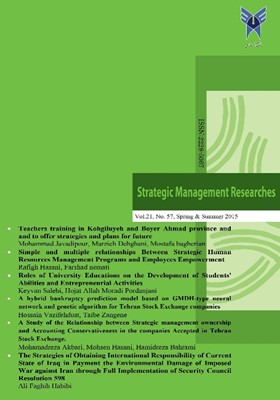A hybrid bankruptcy prediction model based on GMDH-type neural network and genetic algorithm for Tehran Stock Exchange companies
Subject Areas : Strategic Management Researcheshosain vazifehdost 1 , tayebeh zangeneh 2
1 - ..........
2 - دانشجوی دکتری مدیریت بازرگانی،دانشگاه آزاد اسلامی واحدعلوم و تحقیقات
Keywords: Genetic Algorithm, Bankruptcy Prediction, GMDH-type neural network, feature selection method, Tehran Stock Exchange (TSE),
Abstract :
This paper proposes a Soft Computing model for effective bankruptcy prediction, based on the integration of Group Method of Data Handling (GMDH) neural network and genetic algorithm which is called here as GA-GMDH. Genetic algorithm (GA) designs the whole architecture of the GMDH network and optimizes its topology. In order to demonstrate the effectiveness of our proposed GA-GMDH model, its performance was compared with performance of the commonly used statistical techniques of logistic regression (LR) and a relatively new artificial intelligent technique of Adaptive Neuro-Fuzzy Inference System (ANFIS). Performance of the designed prediction models depends on the utilized variable selection technique. Therefore, we constructed 12 prediction models through combining the four filtering feature selection methods and the three prediction models. The four feature selection methods of independent samples T-test, correlation matrix (CM), stepwise multiple discriminant analysis (SDA) and principal component analysis (PCA)are combined with prediction models to generate four optimal feature subsets. Empirical data were collected one year prior to failure from Tehran Stock Exchange (TSE) during 1997-2008. For robust assessing of prediction models’ performance, we applied Type-I and Type-II errors, and area under the receiver operative characteristics curve (AUC) measures. Experimental results indicate that our proposed GA-GMDH model has high ability in bankruptcy prediction problem and significantly outperforms ANFIS and LR models in all combinations with four feature selection methods. Meanwhile, the CM method has the best ability in selecting predictive variables in comparison with other feature selection methods. Therefore, CM-GA-GMDH model is determined as the best constructed model for bankruptcy prediction using our particular dataset from TSE.
فلاح پور، سعید، "پیش بینی درماندگی مالی شرکت ها با استفاده از شبکه های عصبی مصنوعی"، دانشگاه تهران، دانشکده مدیریت، 1383.
روشن قلب، وحید، "بررسی و شناخت نسبت های موثر بر پیش بینی ورشکستگی در شرکت های پذیرفته شده در بورس اوراق بهادار تهران، دانشگاه تهران، دانشکده مدیریت، 1386.
فرج زاده دهکردی، حسن، "کاربرد الگوریتم ژنتیک در مدلبندی پیشبینی ورشکستگی"، پایان نامه کارشناسی ارشد، دانشگاه تربیت مدرس، 1386.
McKee, T.E., Lensberg, T., “Genetic programming and rough sets: A hybrid approach to bankruptcy classification.” European Journal of Operational Research, 138, 2002, pp. 436-451.
Haber, J., “ Theoretical development of bankruptcy prediction variables”, the Journal of Theoretical Accounting Research, 2, 2006, pp.82-101.
Tsai, C. F., “Feature selection bankruptcy prediction”, Knowledge-Based Systems, 22(2), 2009,pp. 120-127.
Aziz, M. A., Dar, H. A., “Predicting corporate bankruptcy: Where we stand?”, Corporate Governance, 6(1), 2006, pp. 18–33.
Ravi Kumar, P., Ravi, V., “Bankruptcy prediction in banks and firms via statistical and intelligent techniques – A review”, European Journal of Operational Research, 180 (1), 2007, pp. 1–28.
Martin,D., “Early warning of bank failure:A logit regression approach”, Journal of banking and Finance,1, 1997, pp. 249-276.
Tabachnich, B., Fidell, L. “Using multivariate Statistics” (4th ed.) .Boston: Allyn & Bacon, 2001.
Kumar, P.R., Ravi, V., “Bankruptcy prediction in banks byfuzzyrule based classifier” , Proceedings of the 2006 first international conference on digital information management, 2006, pp. 222–227.
Verikas, A., Kalsyte, Z., Bacauskie., Gelzinis, A., “Hybrid and ensemble-based soft computing techniques in bankruptcy prediction: a survey” , Soft Comput, 2009.
Zadeh, L.A. , “Soft computing and fuzzy logic”, IEEE Software 11 (6),1994, pp. 48–56.
Malhotra, R., Malhotra, D.K., “Differentiating between good credits and bad credits using neuro-fuzzy systems”, European Journal of Operational Research, 136, 2002, pp. 190-211.
Ravi kumar, P., Ravi, V., “Bankruptcy prediction in banks by an ensemble classifier”, Industrial technology. IEEE International Conference on ICIT,2006, pp. 2032–2036.
Karles, G.V., Prakash, A.J., “ Multivariate normality and forecasting of business bankruptcy”., Journal of Business Finance & Accounting, 14, 1987, pp. 573-593.
Jang, J.-S. R., “ Neuro-Fuzzy and Soft Computing”, Prentice- Hall: New Jersey, 1997.
Ivakhnenko, A.G. “Group Method of Data Handling — a rival of the method of stochastic approximation”, Soviet Automatic Control, 13, 1966, pp. 43–71.
Varetto, F., “ Genetic algorithm application in the analysis of insolvency risk”, Journal of Banking and Finance, 22, 1998, pp. 1421-1439
_||_

